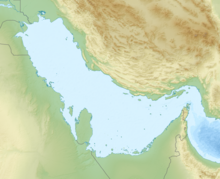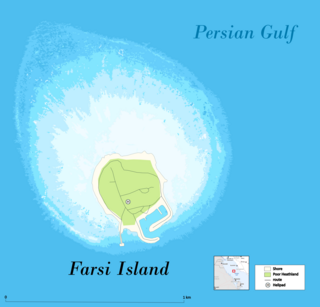
Farsi Island is a tiny, barren Iranian island in the Persian Gulf. There is an IRGC Navy base on this island. The island has an area of about 0.25 km2 (0.10 sq mi) and is restricted from the public. The center of Farsi Island is located at latitude 27° 59' 36" N and longitude 50° 10' 22" E. Its maximum elevation is 4 metres (13 ft). The word Farsi means "Persian".

The Islamic Revolutionary Guard Corps, also called Sepah or Pasdaran, is a multi-service primary branch of the Iranian Armed Forces. It was officially established by Ruhollah Khomeini as a military branch in May 1979, in the aftermath of the Iranian Revolution. Whereas the Iranian Army protects the country's sovereignty in a traditional capacity, the IRGC's constitutional mandate is to ensure the integrity of the Islamic Republic. Most interpretations of this mandate assert that it entrusts the IRGC with preventing foreign interference in Iran, thwarting coups by the traditional military, and crushing "deviant movements" that harm the ideological legacy of the Islamic Revolution. Currently, the IRGC is designated as a terrorist organization by Bahrain, Saudi Arabia, Sweden and the United States.

Stridsbåt 90 H(alv) is a class of fast military assault craft used by several countries after being originally developed for the Swedish Navy by Dockstavarvet. Its name means Combat Boat 90 Half; the 90 refers to the year of acceptance (1990) and Half refers to the fact that it can carry and deploy a half platoon of amphibious infantry fully equipped. The CB90 is an exceptionally fast and agile boat that can execute extremely sharp turns at high speed, decelerate from top speed to a full stop in 2.5 boat lengths, and adjust both its pitch and roll angle while under way. Its light weight, shallow draught, and twin water jets allow it to operate at speeds of up to 40 knots (74 km/h) in shallow coastal waters. The water jets are partially ducted, which, along with underwater control surfaces similar to a submarine's diving planes, gives the CB90 its manoeuvrability.

The Navy of the Islamic Revolutionary Guard Corps is the naval warfare service of the Islamic Revolutionary Guard Corps founded in 1985, and one of the two maritime forces of Iran, parallel to the conventional Islamic Republic of Iran Navy. The IRGC has been designated as a terrorist organization by the governments of Bahrain, Saudi Arabia and the United States. IRGC's Navy has steadily improved its capabilities to support unconventional warfare and defend Iran's offshore facilities, coastlines, and islands in the Persian Gulf.

On 23 March 2007, fifteen Royal Navy personnel from HMS Cornwall were searching a merchant vessel when they were surrounded by the Navy of the Iranian Revolutionary Guards and detained off the Iran–Iraq coast. In the course of events, British forces claimed that the vessel was in Iraqi waters, but the Iranians insisted that they were in Iran's territorial waters. The fifteen personnel were released thirteen days later on 4 April 2007.

The Iranian Armed Forces, officially the Islamic Republic of Iran Armed Forces, are the combined military forces of Iran, comprising the Islamic Republic of Iran Army (Artesh), the Islamic Revolutionary Guard Corps (Sepah) and the Law Enforcement Force (Faraja).
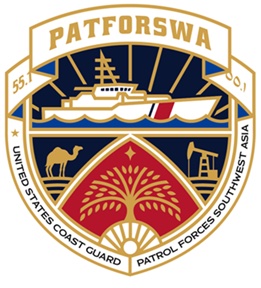
Patrol Forces Southwest Asia (PATFORSWA) is a United States Coast Guard command based in Manama, Bahrain. PATFORSWA was created in November 2002 as a contingency operation to support the U.S. Navy with patrol boats. The command's mission is to train, equip, deploy, and support combat-ready Coast Guard forces conducting operations in support of Operation Iraqi Freedom (OIF), Operation Enduring Freedom (OEF), Operation Inherent Resolve (OIR) in the Naval Forces Central Command's area of responsibility. It was commissioned as a permanent duty station in June 2004. In July 2003, PATFORSWA moved from its own compound to facilities at Naval Support Activity Bahrain.

USCGC Monomoy (WPB-1326) was a United States Coast Guard Island class patrol cutter. She was the 26th ship of her class. The second ship of the Coast Guard to bear the name, Monomoy was named after Monomoy Island which lies off the coast of Cape Cod.
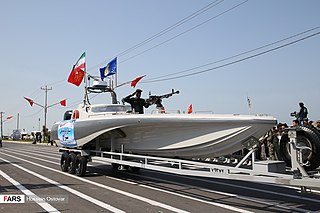
Seraj-1 is a military speed boat that is used by Iran Revolutionary Guard Corps. It is based on the British made Bradstone Challenger, a Bladerunner 51, which holds the record for the fastest circumnavigation of Britain. Militarized speed boats have been the core of the Iranian military doctrine since their commanders believe that speed boats can counter the USA's massive warships.
The Great Prophet IX was an Iranian war games exercise in the general area of the Strait of Hormuz on Larak Island, Persian Gulf. It started on February 25, 2015, and finished on February 27, 2015. The exercise was notable for using a full scale mock-up of an American aircraft carrier as a target.

Ali Fadavi is an Iranian military officer who currently holds office as the deputy commander-in-chief of the Islamic Revolutionary Guard Corps.

Amir Ali Hajizadeh is commander of Aerospace Force of the Islamic Revolutionary Guard Corps since October 2009.
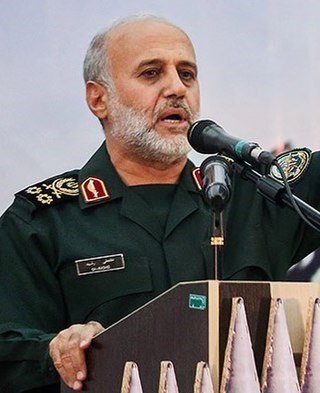
Major general Gholam Ali Rashid is an Iranian military commander who is the commander of Khatam-al Anbiya Central Headquarter and former deputy chief of the General Staff of Armed Forces of the Islamic Republic of Iran who was among decision-making commanders in the Iran–Iraq War. He along with Mohammad Ali Ja'fari, Ali Fadavi, Qasem Soleimani, and Mohammad Bagheri was the member of command network in the Armed Forces of the Islamic Republic of Iran.
2016–present clashes in West Iran refers to the ongoing military clashes between Kurdish insurgent party Democratic Party of Iranian Kurdistan (PDKI) and the Iranian Revolutionary Guards, which began in April 2016. Kurdistan Freedom Party (PAK) and Komalah expressed their support to the Kurdish cause of PDKI as well, with both clashing with Iranian security forces in 2016 and 2017 respectively. In parallel, a leftist Iranian Kurdish rebel group PJAK resumed military activities against Iran in 2016, following a long period of stalemate.

The Saegheh is an Iranian turbofan/piston-powered flying wing unmanned combat aerial vehicle (UCAV) produced by Shahed Aviation Industries. It is based on, but smaller than and substantially different from, a Lockheed Martin RQ-170 Sentinel UAV that was captured by Iran in 2011 and then reverse-engineered. It is one of two Iranian flying wing UAVs based on the RQ-170, along with the Shahed 171 Simorgh, a larger version.

Hossein Alaei is an Iranian retired military officer who served as the CEO of Iran Aseman Airlines from 2013 to 2018. During his military career, Alaei was among senior Islamic Revolutionary Guard Corps commanders, having served as its commander in two northwestern provinces, Karbala HQ, maritime forces and the joint staff. He was also defense minister's deputy in the 1990s and early 2000s.

Commodore Alireza Tangsiri is an Iranian military officer and the current commander of Navy of the Islamic Revolutionary Guard Corps appointed since 23 August 2018, replacing Ali Fadavi.

On June 20, 2019, Iran's integrated system of Air Defense Forces shot down a United States RQ-4A Global Hawk BAMS-D surveillance drone with a surface-to-air missile over the Strait of Hormuz. Iran and the U.S. differ on where the incident actually occurred. Iranian officials said that the drone violated their airspace, while U.S. officials responded that the drone was in international airspace.
Iran's Islamic Revolutionary Guard Corps stated on 25 October 2021 that they had thwarted an attempt by the United States to capture and detain a tanker carrying Iranian oil in the gulf of Oman by carrying out a heliborne operation and directing the ship back to Iran's territorial waters. The Pentagon rejected the Iranian statement and said that Iranian forces had seized a Vietnamese-flagged oil tanker in October.
